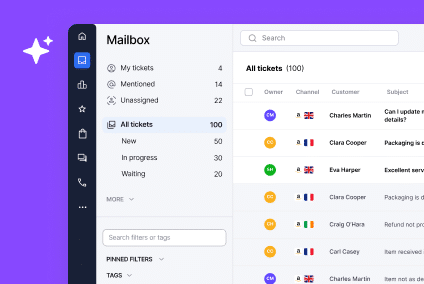Inventory management – it’s not exactly a glamorous phrase, but it is the backbone of every successful eCommerce business. This means that getting your inventory management process right can mean the difference between steady sales and costly stockouts or overstocks.
If you’re selling on platforms like Amazon (whether through FBA Amazon or your own fulfillment setup) staying on top of your stock is a top priority. That said, inventory control can be a sizable challenge thanks to hurdles like forecasting demand, syncing stock across channels, and juggling SKUs.
But have no fear, because this guide breaks down the essentials of inventory management in 2025, sharing practical tips, must-have tools, and handy templates you can use right away. Maybe you’re just starting out, or maybe you’re scaling up – either way, these insights will help you avoid common pitfalls and help you keep on top of your stock.
Why does the inventory management process matter so much?
If you’re just starting out, you’d be forgiven for thinking that the inventory management process is just about knowing what’s on your shelves.
But the reality is this: Inventory management process is a strategic cornerstone that affects nearly every part of your business.
Why, exactly? Let us explain.
It keeps customers happy by avoiding stockouts
Nothing annoys customers like finding out their favorite product is out of stock, especially when they’re ready to buy right now. As well as lost sales, stockouts hurt your reputation and drive people to your competitors. Keeping a close eye on your inventory means you make sure products are available when customers want them. That helps build trust, and it keeps people coming back for more.
It prevents lost sales from running out of popular items
Your top sellers are the heart of your business. When you run out of those, it’s like closing the door on easy money. A good inventory management process helps you spot when a product is flying off the shelves, so you can reorder before you run dry. Keeping those bestsellers stocked means steady sales and a healthier bottom line.
It minimizes excess inventory that ties up cash and storage space
On the flip side, holding too much stock isn’t a good move either. It ties up your cash in products that aren’t moving, and it fills up storage space you could be putting to better use. To add to that, some products might go out of style or expire, turning your investment into a loss. Smart inventory management means finding that sweet spot: enough stock to meet demand, but not so much that you’re drowning in piles of unsold items.
It improves forecasting to meet demand without waste
Forecasting might sound fancy, but it’s really all it means is looking at past sales and trends to predict what you’ll need in the future. Get it right and you’ll avoid ordering too much or too little. It helps you keep customers happy while saving money by not overstocking. This means using data to plan your stock. The numbers don’t lie, and they’ll enable you to work smarter, not harder.
It syncs stock levels across channels like Amazon Seller Central, your website, and marketplaces
Selling on different platforms means juggling inventory across each one, and it’s all too easy to wind up selling items you don’t actually have, which leads to cancellations and unhappy customers. Syncing is the solution for this risk. Automating your stock updates across Amazon Seller Central, your website, and other channels keeps everything accurate and up to date. It saves you time and headaches, and it makes sure your customers get what they order.
So there you have it, some pretty huge advantages to getting your inventory management process right. And when you get all these moving parts working well together, your day-to-day runs smoother, your money flows better, and your customers stay happy…in other words, you get a recipe for business growth.
But getting there isn’t always easy. Inventory management comes with its fair share of challenges that catch even experienced sellers off guard. Let’s take a look at some of the common hurdles you might face so you know what to watch out for.
The top five most common inventory challenges
Managing inventory comes with its fair share of headaches. So let us introduce you to a few common troublemakers that can seriously ruin a seller’s day if left unchecked. To make it real, we’ll share some examples from sellers just like you. The good news? Knowing what you’re up against is the first step to staying ahead.
Inaccurate demand forecasting
Leila runs a small fitness accessories brand and based her orders on last year’s sales alone.
But when demand shifted, she ended up with a warehouse full of yoga mats nobody wanted. Guessing wrong on demand means you either tie up cash in excess stock or miss out on sales when you run low.
Like Leila, many sellers learn the hard way that demand forecasting needs data, not just vibes.
Multichannel confusion
Tim sells electronics sing the Amazon FBA program, but he also runs his own site.
Because he didn’t sync stock between platforms, Tim accidentally sold the same laptop twice: once on Amazon, once on his website.
Keeping inventory synced across marketplaces and warehouses is tricky but it’s vitally important. Otherwise, you risk overselling, unhappy customers, and time-consuming cancellations.
SKU overload
Priya’s handmade candle business soared in popularity. She was thrilled, but she found herself suddenly managing hundreds of SKUs. Without a clear system or a good SKU generator, she found herself mixing up orders and mislabeling products.
When your SKU list grows long, disorganization sneaks in. A solid system helps you keep track, process orders faster, and avoid costly mistakes.
Manual tracking errors
When he launched his business, Derek kept inventory updated using a spreadsheet. But then the business started to grow. He found that with daily sales across three platforms, manual updates led to mistakes and missed alerts.
As Derek learned very quickly, relying on manual tracking doesn’t scale well and can cause costly errors. Automated tools save time, reduce mistakes, and keep your stock data reliable.
Fulfillment center delays
Juno sells beauty products through an Amazon fulfillment center. When a supplier shipment got delayed, she didn’t know in time and ran out of her most popular skincare kits.
Shipping and receiving issues can cause stock shortages if you’re not closely monitoring your supply chain. But keeping tabs on your fulfillment center’s schedules helps avoid nasty surprises.
That’s it, our top five biggest inventory management challenges in 2025. Fortunately, there are ways to tackle these obstacles and come out swinging. Next, let’s take a look at how the top sellers do it. It’s time for some best practices.
Get SMART with the best practices for inventory management in 2025
To tackle inventory challenges head-on, just think SMART:
S for sales forecasting
Forecast smarter, not harder.
Stop guessing and start planning with real data. Look back at what sold well and when to get a clearer picture of what’s coming next. Smart, data-driven forecasting means you order just the right amount of stock, avoiding costly overstock or disappointing stockouts.
Tool tip: Use Amazon Seller Central’s sales reports to spot trends and consider the forecasting features in DSM Tool to sharpen your predictions.
M for multichannel automation
Automate syncing to save time and headaches
Manually updating stock across channels is a hassle and invites mistakes. Let automation do the heavy lifting, so that every sale updates your inventory in real time, no matter where it happens. This keeps your stock counts accurate and your customers happy.
Tool tip: DSM Tool is great for syncing inventory across platforms, and the Amazon Seller App lets you manage stock on the move.
A for accountable SKUs
Keep your SKUs neat and tidy
As your product range grows, messy SKUs can slow you down and cause confusion. A reliable SKU generator helps you create clean, consistent codes that make tracking and order fulfillment a breeze. Staying organized means fewer errors and smoother operations.
Tool tip: Use a dedicated SKU generator tool to keep your product codes consistent and easy to manage.
R for routine audits
Regular stock audits catch problems early
Software is very useful, but don’t rely on it completely. Make sure you get hands-on with your inventory too. Regular physical audits help you spot issues like misplaced items or shrinkage before they become costly problems. Combining digital tracking with real-world checks keeps your stock data solid.
Tool tip: Use inventory management reports from Amazon Seller Central or your DSM Tool to compare with your physical counts and catch discrepancies.
T for timely fulfillment
Master your fulfillment timing with partners
If you rely on the Amazon FBA program or other fulfillment centers, staying on top of their lead times and reorder points is key. Knowing when stock is arriving or running low lets you plan ahead and avoid last-minute scrambles. Good communication with your fulfillment partners keeps everything running smoothly.
Tool tip: Track shipment status and lead times through your fulfillment center’s dashboard and set reorder alerts within your inventory management system.
You’ll notice we’ve already thrown in a few tool recommendations here. But there are plenty more out there, so next let’s dive deeper and explore the best options for tracking, forecasting, and syncing your inventory.
Essential tools and templates for inventory control
Thinking SMART is a great start, but having the right tools and templates in your corner makes all the difference.
The world of inventory management tech is huge, and there are plenty of options that can make your life easier. Let’s take a closer look at some of the best tools and templates for tracking your stock, forecasting demand, and keeping everything synced across your sales channels.
The best tools and templates for tracking stock
- Amazon Seller Central is, of course, your command center if you’re selling on Amazon. It gives you up-to-the-minute stock updates, sales data, and low-stock alerts, making it perfect for staying ahead without the guesswork.
- DSM Tool is a favorite for dropshippers and multichannel sellers who want to automate listings and keep inventory levels accurate across platforms without breaking a sweat.
- The FBA Amazon Calculator helps you crunch the numbers on fees and profitability for each product. Understanding these costs is key when deciding how much stock to carry and pricing products smartly.
- Templates: If you’re just getting started or prefer to keep things simple, grab some stock tracking templates like the Vertex42 inventory spreadsheet or Smartsheet’s free-trial Excel inventory templates. SellerChamp’s Amazon FBA Checklist is useful for making sure you don’t miss a vital step in your inventory control process.
The best tools for forecasting demand
- Amazon Seller Central’s reports are a solid starting point, showing you what’s sold in the past and when demand typically peaks.
- DSM Tool gives you a more hands-off approach, with forecasting features to help you anticipate trends without the heavy lifting.
- Inventory Planner offers something dedicated, diving deep into sales velocity, seasonality, and supplier lead times to recommend exactly how much stock you’ll need.
- Extensiv packs forecasting into a broader operations platform, helping you stay stocked without overcommitting cash.
- Templates: HubSpot’s free sales forecasting template helps you crunch your own numbers to predict what’s next. Vena Solutions’ free inventory forecasting template for Excel gives you insights based on product demands and more.
The best tools for syncing inventory across channels
- DSM Tool shines here by updating your stock levels instantly across all your sales channels, so you don’t accidentally sell what you don’t have.
- Sellbrite specializes in syncing inventory and orders across marketplaces like Amazon, eBay, and Walmart. Plus, they offer a handy free inventory management template if you want to manage manually.
- ChannelAdvisor handles syncing across dozens of channels, making sure your numbers add up everywhere.
- An honorable mention also to the Amazon Seller App, which lets you scan barcodes, update stock, and keep tabs on sales, right from your phone.
- Templates: Meegle’s Inventory Sync Batch Processing Template helps you keep your inventory synced across different platforms by making the process easier and reducing mistakes.
Using these tools alongside your SMART approach and templates means you’re equipped to manage your inventory confidently and keep your business running smoothly.
Master inventory, delight your customers, grow your business
So, nope, your inventory management process will never be the flashiest part of your business. But is it one of the most important parts? Absolutely! And hopefully this blog has shown you why.
So, nail your process, use the right tools, and stay on top of your stock. In return, you’ll avoid costly headaches like stockouts, overselling, and wasted cash.
With a SMART approach and some good tools, managing inventory won’t be a constant scramble. You’ll find that it can be a smooth, predictable part of your daily operations.
And while you’re mastering your stock, don’t forget how crucial customer conversations are. Keeping those running smoothly across every channel makes sure your customers stay happy and loyal.
eDesk brings all your customer chats from email, social, live chat, and marketplaces into one central inbox. Plus, it uses AI-powered automation to handle routine tasks like sorting, tagging, and replying to common questions. This means less manual work for you and your team, faster response times for customers, and fewer missed messages.
Think this could help? Booking a demo is the easiest way to see exactly how eDesk fits your workflow.




